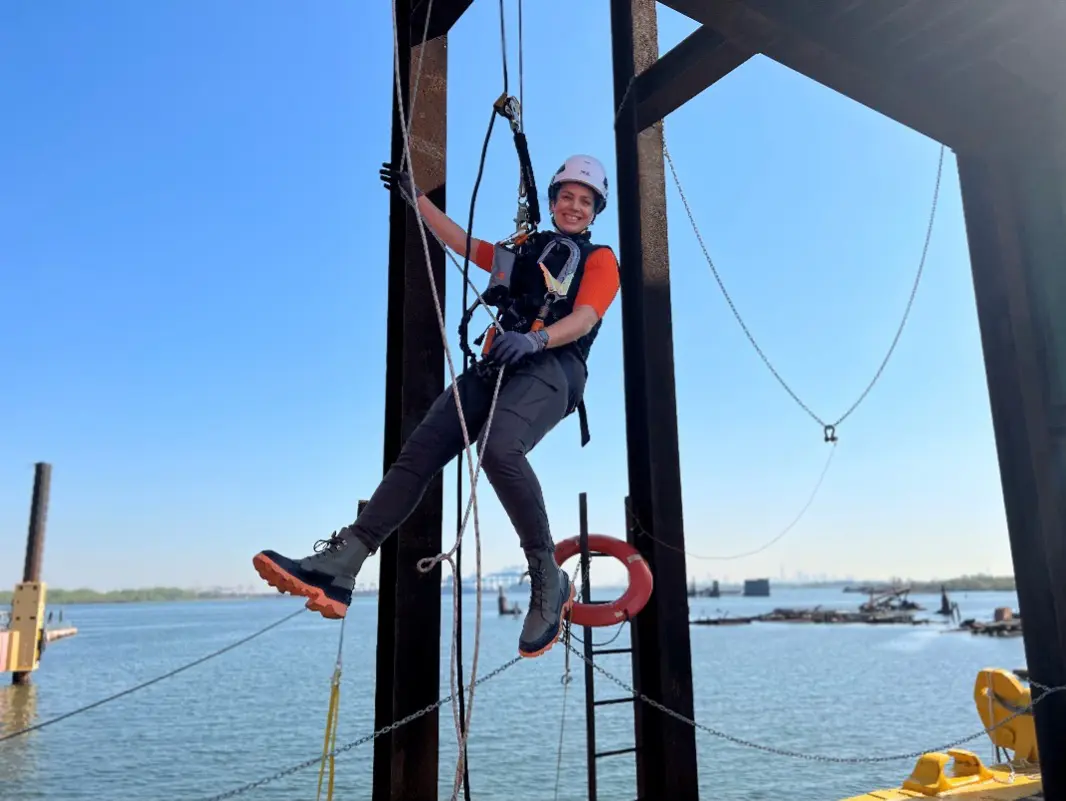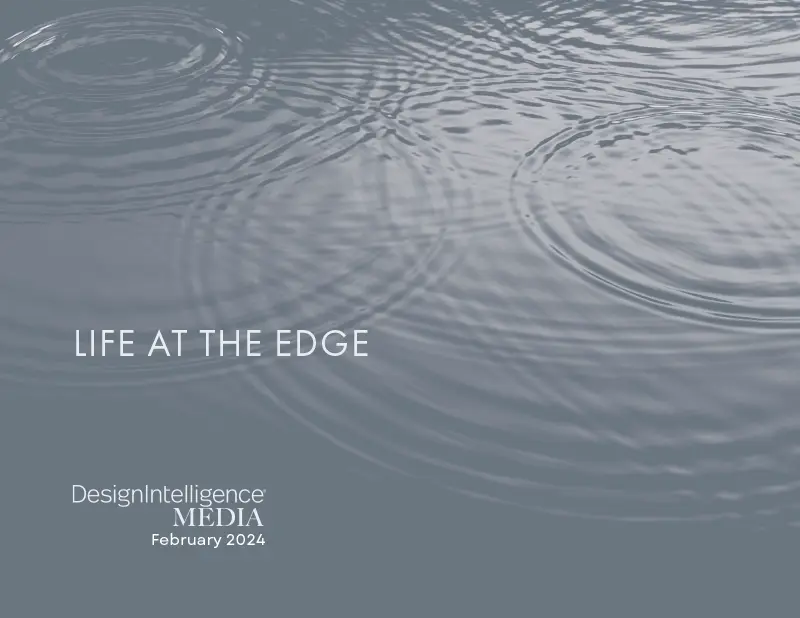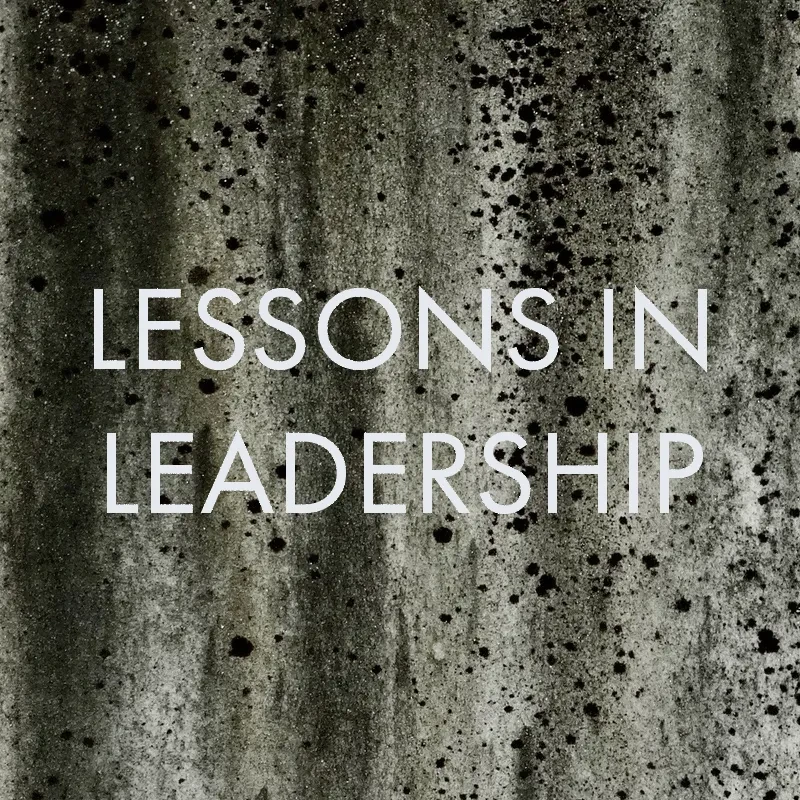
Life at the Edge
Dena Prastos, AIA
Founder & CEO of Indigo River
February 14, 2024
Dena Prastos discusses issues and opportunities in waterfront and infrastructure design.
DesignIntelligence (DI): We’re honored to have Dena Prastos, AIA, a woman driven to transform the built world at the water’s edge. As founder and CEO of Indigo River, she is the first “waterfront architect” focusing on architecture, resiliency and climate adaptation. A leading authority in New York Harbor and beyond, she specializes in climate adaptation. In addition to working with clients like the Trust for Governors Island, Scenic Hudson and NYC Economic Development Corporation, she is also working on Robert De Niro’s new Wildflower Studios in Astoria. Waterfront architect, civil engineer, futurist, climate adaptation expert and entrepreneur, she is fueled by the intersection of design, technology, community and nature. Welcome, Dena.
Dena Prastos (DP): Hi Michael. Thank you for having me!
DI: You have created such a unique niche for yourself and your firm. How did you get there? What shaped you? What was the journey like?
DP: I’m a firm believer that our differences are what make us interesting. And how we respond to challenges are often key opportunities to differentiate ourselves. I have developed my mindset to reframe challenges as opportunities almost automatically, which has largely gotten me to where I am. For example, upon completing my architecture degree, I leaned into an area where I felt challenged: the technical. I addressed this by completing a master’s degree in civil engineering. Then, I started my career at a heavy civil construction firm that cast a wide net in terms of my areas of interest. In this role, I could start digging into the practical things like construction and field execution. During the early days before launching Indigo River, my career shifted from construction to engineering to architecture to a combination of those disciplines. I have worked from New York to Key West and Tel Aviv to Tbilisi. Eventually, I hit a glass ceiling in the corporate world and realized the clearest way to retake control of my career was to launch a company of my own.
In many ways, my career outlines how obstacles can go on to become the way. Some experiences I look back on as pivotal in shaping me as a professional were adversity in the work environment, working abroad and establishing and maintaining professional relationships.

Author photo
DI: What events or experiences — maybe motivation is a better word — drove you to practice at the edge of the earth, where land meets water?
DP: I have always had a deep love and admiration for nature, and specifically for water bodies. I believe it is by nature that we can learn, advance, replicate and scale our actions to address goals. Sixty percent of humanity (three billion people) live on or near a coast, which makes protecting and adapting infrastructure where land meets water one of the most complex and pressing issues of our time.
The waterfront is a dynamic zone. As a result, coastal regions have inherent vulnerabilities, repeatedly and constantly exposed to raw, often unpredictable natural forces (which are expected only to get worse as we progress through the 21st century). So, it deserves specialized attention. For these reasons, I have found gratitude and purpose in focusing my career and company on this typology.
DI: With such an exciting, unique practice, how are you looking at the world these days?
DP: Top of mind is to educate the public on the evolving and critical role architects should be playing at the earliest stages (and all stages) of any project in the built environment. It saddens me when I see failings in our infrastructure that could have been avoided.
DI: What gets you up in the morning?
DP: My sacred morning rituals: Waking early. Enjoying a hot cup of coffee outside while watching the sunrise and walking my two dogs. Practicing yoga and getting my cardio in early, most often by cycling. That way, whatever the rest of the day holds, I start it by feeling energized and accomplished.
DI: With the discussions around climate change — often political — have you needed to develop any strategies for persuading potentially resistant clients and constituents of necessary or complex issues in your projects?
DP: Yes. In today’s rapidly changing world, discussions around climate change have become increasingly prominent. As a waterfront architect, I believe it’s our responsibility to integrate sustainable and resilient design principles into our projects. It is not uncommon to encounter resistance from clients and constituents who may have differing concerns, but I make it a point to listen and engage with all perspectives.
DI: What is your approach to those difficult conversations? For example, traditional short-term, first-cost thinking vs. long-term infrastructure investment for future generations and beneficiaries?
DP: My approach involves a combination of education, collaboration, economic reasoning, local context and advocacy to persuade clients and constituents of the necessity to address complex issues like climate change in our projects. Our goal is to create aesthetically pleasing and functional spaces and contribute to a more sustainable and resilient future for waterfront communities through these strategies:
Education
One of the most effective ways to overcome resistance is through education. I provide our clients and stakeholders with up-to-date
information and research on the impacts of climate change, not just globally but specifically in the context of the waterfront projects
we’re working on. Sharing data, case studies and examples of successful projects can help illustrate the urgency and benefits of sustainable
design.
Collaboration
I emphasize the importance of collaboration throughout the design process. By involving clients, community members and other stakeholders
early on, we can ensure their concerns and perspectives are considered. This collaborative approach fosters a sense of ownership and can
lead to more receptive attitudes toward sustainable and resilient design solutions.
Economic Benefits
Climate-resilient and sustainable design can be financially advantageous. I work to demonstrate how these strategies can lead to long-term
cost savings, improved property values and reduced operational expenses. Providing a clear financial incentive can often persuade even the
most resistant clients.
Local Context
Understanding the unique needs and priorities of the community where the waterfront project is located is crucial. I conduct thorough
research to tailor our designs to fit the local context and address environmental and social concerns. This approach helps build trust and
support among constituents.
Advocacy
As a progressive architect, I’m also an advocate for climate-adaptive design. I actively engage in public forums, share my expertise and
participate in discussions about climate change and its impact on the built environment. This not only raises awareness but also helps shape
public opinion, making it easier to garner support for forward-thinking projects.
Flexible Design
I emphasize the flexibility of our designs to adapt to future changes. By acknowledging the uncertainty surrounding climate change and
designing for resilience, we can reassure clients and constituents that their investments will stand the test of time.
DI: Are there any new economic models and investments that can leverage myopic ways of thinking?
DP: I recently had a discussion over coffee with a climate expert on precisely this topic. The consensus was that finding profit in “avoided losses” is not compatible with our investment community’s current way of thinking. If someone were to design a way to directly invest and profit from these avoided losses, the flow of capital toward resiliency and adaptation investments would likely change quickly.
DI: Because of the scarcity and shared nature of coastlines, do issues such as private ownership vs. public access and riparian rights come into play? To date, it seems money and power shape those rules.
DP: In many cases, the rules and regulations governing coastlines result from ongoing negotiations and conflicts between various stakeholders, including private property owners, public access advocates, environmentalists and government authorities. Achieving a fair and sustainable balance between these competing interests is a complex process my company “navigates” daily.
Sea level rise, storm surges and unprecedented flood events are a daily occurrence; we must reconsider the relationship between nature and the built environment.
DI: Are you investigating any new systems based on larger-scale planning, such as PPP, to benefit from scale and broader change in legislation and economics only achievable through holistic vs. individual projects?
DP: Yes. We endeavor to achieve this through transdisciplinary design. Transdisciplinary design is our approach to climate adaptation work that brings together professionals from different fields, such as architects, engineers, planners and scientists, to collaborate on solving complex problems related to climate change.
In the context of climate adaptation, transdisciplinary design involves designing and implementing solutions at different scales that address the social, economic and environmental dimensions of climate change. It involves a holistic approach that recognizes climate change is not just an environmental problem but also a social and economic one requiring multipronged solutions.
For example, our transdisciplinary design team may work on developing a climate-resilient community that integrates green infrastructure, such as bioswales and green roofs, with traditional engineered infrastructure, such as drainage systems and wastewater treatment plants. The team may also work on creating public spaces that serve as both recreational areas and flood protection zones.
We recognize the importance of collaboration and integration across multiple disciplines and at various scales to develop sustainable solutions that address the complex challenges of climate change.
DI: Since water invokes a vast set of natural and biological issues (e.g., ecosystems, biological, wind, plant and animal life) in addition to traditional architectural forces, have you armed yourself with scientists and experts to inform your work?
DP: Absolutely. For precisely those reasons, we have developed quite a multidisciplinary team in-house, including traditionally trained architects, landscape architects, naval architects, urban planners, climate adaptation specialists and civil, geotechnical, structural, marine, coastal and dive engineers. In addition, we often engage outside specialty consultants, like ecologists and species-specific scientists, to augment project- and site-specific needs.
DI: Your website talks about the intersection of design technology and nature. Specifically, how does technology factor in? Are you talking about your toolset in design or the influence of technological forces on society?
DP: Both. There is no question technology has become integral in our design process. From common uses such as digital models to complex simulation models, advances in material science, aerial and submarine drone deployment and, finally, keeping it all together with the latest project management solutions, technology touches nearly everything we do.
DI: Beyond the technical execution of the work, outside your firm, who do you consider on your “team” — others that inspire you and fuel your fire?
DP: My family, friends and industry peers. Most notably, my husband, business partner, parents and brothers.
DI: Practicing in New York must entail a set of considerations unfamiliar to most design professionals. Beyond that, working on high-profile, high-visibility, high-impact projects with recognizable clients like Robert De Niro must involve a set of contexts few will be familiar with. Can you share some of those? Perhaps they are scalable and helpful to others.
DP: Certainly! Practicing waterfront architecture in New York City is a privilege. On any given day, I could be having discussions with famous architects, designers, actors, politicians, astronauts, renowned laureates or other public figures. As an introvert, the recipe that has worked for me has been to prepare, rehearse and exercise beforehand — and to ensure I am well-hydrated! Although not always within my control, I also keep screen time before bed to a minimum to maximize my chances for good rest.
DI: What have I forgotten to ask about life at the edge? Final thoughts, actions?
DP: Yesterday’s climate extremes are today’s new normal. We must adapt to a world in which the climate is less predictable and, in many cases, less favorable than it has been in the past. Sea level rise, storm surges and unprecedented flood events are a daily occurrence; we must reconsider the relationship between nature and the built environment.
Because architects are licensed to protect the health, safety and welfare of the public in the built environment, adaptation is essential for the profession and the public moving forward. I firmly believe climate adaptation is our generation’s calling, and I have found purpose as a waterfront architect specializing in resiliency measures.
Dena Prastos, AIA, is Indigo River’s founder and CEO, the first “waterfront architect” trailblazing a new category at her women-owned transdisciplinary design firm. A leading authority in New York Harbor, her firm focuses on progressive waterfront architecture, resiliency and climate adaptation solutions that seamlessly transcend boundaries. Waterfront architect, civil engineer, futurist, climate adaptation expert and entrepreneur, Dena is driven to transform the built world at the water’s edge and is fueled by the overlapping of design, technology, community and nature.




